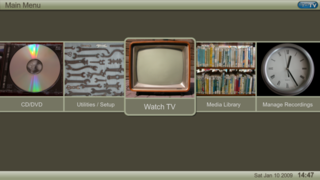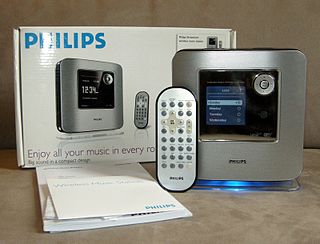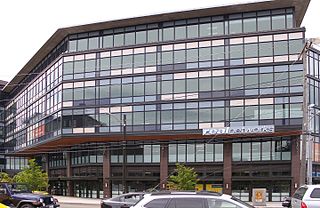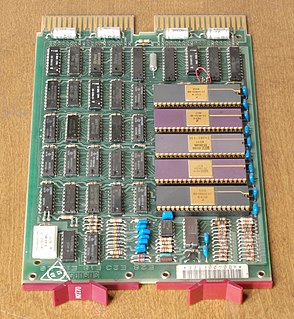Helix DNA is a project to produce computer software that can play audio and video media in various formats, aid in producing such media, and serve them over a network. It is intended as a largely free and open-source digital media framework that runs on numerous operating systems and processors and was started by RealNetworks which contributed much of the code. The Helix Community is an open collaborative effort to develop and extend the Helix DNA platform.
Windows Media Video (WMV) is a series of video codecs and their corresponding video coding formats developed by Microsoft. It is part of the Windows Media framework. WMV consists of three distinct codecs: The original video compression technology known as WMV, was originally designed for Internet streaming applications, as a competitor to RealVideo. The other compression technologies, WMV Screen and WMV Image, cater for specialized content. After standardization by the Society of Motion Picture and Television Engineers (SMPTE), WMV version 9 was adapted for physical-delivery formats such as HD DVD and Blu-ray Disc and became known as VC-1. Microsoft also developed a digital container format called Advanced Systems Format to store video encoded by Windows Media Video.
Windows Media is a discontinued multimedia framework for media creation and distribution for Microsoft Windows. It consists of a software development kit (SDK) with several application programming interfaces (API) and a number of prebuilt technologies, and is the replacement of NetShow technologies.

MythTV is a free and open-source home entertainment application with a simplified "10-foot user interface" design for the living room TV. It turns a computer with the necessary hardware into a network streaming digital video recorder, a digital multimedia home entertainment system, or home theater personal computer. It can be considered a free and open-source alternative to TiVo or Windows Media Center. It runs on various operating systems, primarily Linux, macOS, and FreeBSD.
Digital Living Network Alliance (DLNA) was founded by a group of PC and consumer electronics companies in June 2003 to develop and promote a set of interoperability guidelines for sharing digital media among multimedia devices under the auspice of a certification standard. DLNA certified devices include smartphones, tablets, PCs, TV sets and storage servers; in a typical use case, a user sends videos, pictures or music from their smartphone or storage server through their home WLAN to a TV set or tablet for display.

Streamium was a line of IP-enabled entertainment products by Dutch electronics multi-national Philips Consumer Electronics. Streamium products use Wi-Fi to stream multimedia content from desktop computers or Internet-based services to home entertainment devices. A Streamium device plugged into the local home network will be able to see multimedia files that are in different UPnP-enabled computers, PDAs and other networking devices that run UPnP AV MediaServer software.
Windows Media DRM or WMDRM, is a Digital Rights Management service for the Windows Media platform. It is designed to provide delivery of audio or video content over an IP network to a PC or other playback device in such a way that the distributor can control how that content is used.
Project DReaM was a Sun Microsystems project aimed at developing an open interoperable DRM architecture that implements standardized interfaces. Its primary goal was the creation of a royalty-free digital rights management industry standard. On 22 August 2005, Sun announced that it was opening up Project DReaM, which had started as an internal research project, as part of their Open Media Commons initiative. It was released under the Common Development and Distribution License (CDDL). Due to inactivity on the project, it was closed and archived in August 2008. DReaM is an acronym that stands for "DRM everywhere/available".

Defective by Design is an anti-DRM initiative by the Free Software Foundation. DRM technology, known as "digital rights management" technology by its supporters, restricts users' ability to freely use their purchased movies, music, literature, software, and hardware in ways they are accustomed to with ordinary non-restricted media. As a result, DRM has been described as "digital restrictions management" or "digital restrictions mechanisms" by opponents.
Forscene is an integrated internet video platform, video editing software, covering non linear editing and publishing for broadcast, web and mobile.
This is a comparison of digital video recorder (DVR), also known as personal video recorder (PVR), software packages. Note: this is may be considered a comparison of DVB software, not all listed packages have recording capabilities.
PassAlong Networks, also known as Tennessee Pacific Group, LLC, was a developer of digital media innovations and services located in Franklin, Tennessee. The company had a digital music library of 3 million licensed songs—two million of which are raw MP3 music files, and provided a series of products and services in the digital media marketplace.
OMS Video is an open, royalty-free video compression specification that was under development by Sun Microsystems's Open Media Commons as part of the Open Media Stack. It defines a video decoder and the associated bitstream syntax. It is intended for delivery, storage and playback of video streams.

VP8 is an open and royalty free video compression format owned by Google and created by On2 Technologies as a successor to VP7.

RealNetworks, Inc. is a provider of Internet streaming media delivery software and services based in Seattle, Washington, United States. The company also provides subscription-based online entertainment services and mobile entertainment and messaging services.
The HTML5 specification introduced the video element for the purpose of playing videos, partially replacing the object element. HTML5 video is intended by its creators to become the new standard way to show video on the web, instead of the previous de facto standard of using the proprietary Adobe Flash plugin, though early adoption was hampered by lack of agreement as to which video coding formats and audio coding formats should be supported in web browsers.
The Helix Universal Media Server was a product developed by RealNetworks and originates from the first streaming media server originally developed by Progressive Networks in 1994. It supported a variety of streaming media delivery transports including MPEG-DASH RTMP (flash), RTSP (standard), HTTP Live Streaming (HLS), Microsoft Silverlight and HTTP Progressive Download enabling mobile phone OS and PC OS media client delivery.
Wowza Streaming Engine is a unified streaming media server software developed by Wowza Media Systems. The server is used for streaming of live and on-demand video, audio, and rich Internet applications over IP networks to desktop, laptop, and tablet computers, mobile devices, IPTV set-top boxes, internet-connected TV sets, game consoles, and other network-connected devices. The server is a Java application deployable on most operating systems.







